Training and Development in Hospitality: Models and Implementation
VerifiedAdded on 2023/06/11
|9
|1349
|75
Report
AI Summary
This report provides an overview of training and development, emphasizing its importance in the workplace, particularly within the hospitality management system. It explores various models and theories, notably the ADDIE model (Analysis, Design, Development, Implementation, Evaluation) and learning theories such as behaviorism, cognitivism, and constructivism. The report details each stage of the ADDIE model, highlighting the significance of analysis, design, development, implementation, and evaluation in creating effective training programs. Furthermore, it explains how learning theories influence training practices by suggesting appropriate methodologies and formats for learning, ensuring the creation of engaging and useful courses. Examples are provided to illustrate the application of each theory in online learning contexts. The report concludes by underscoring the value of training and development in enhancing employee skills and knowledge, and in facilitating effective communication across diverse cultures within the hospitality sector.
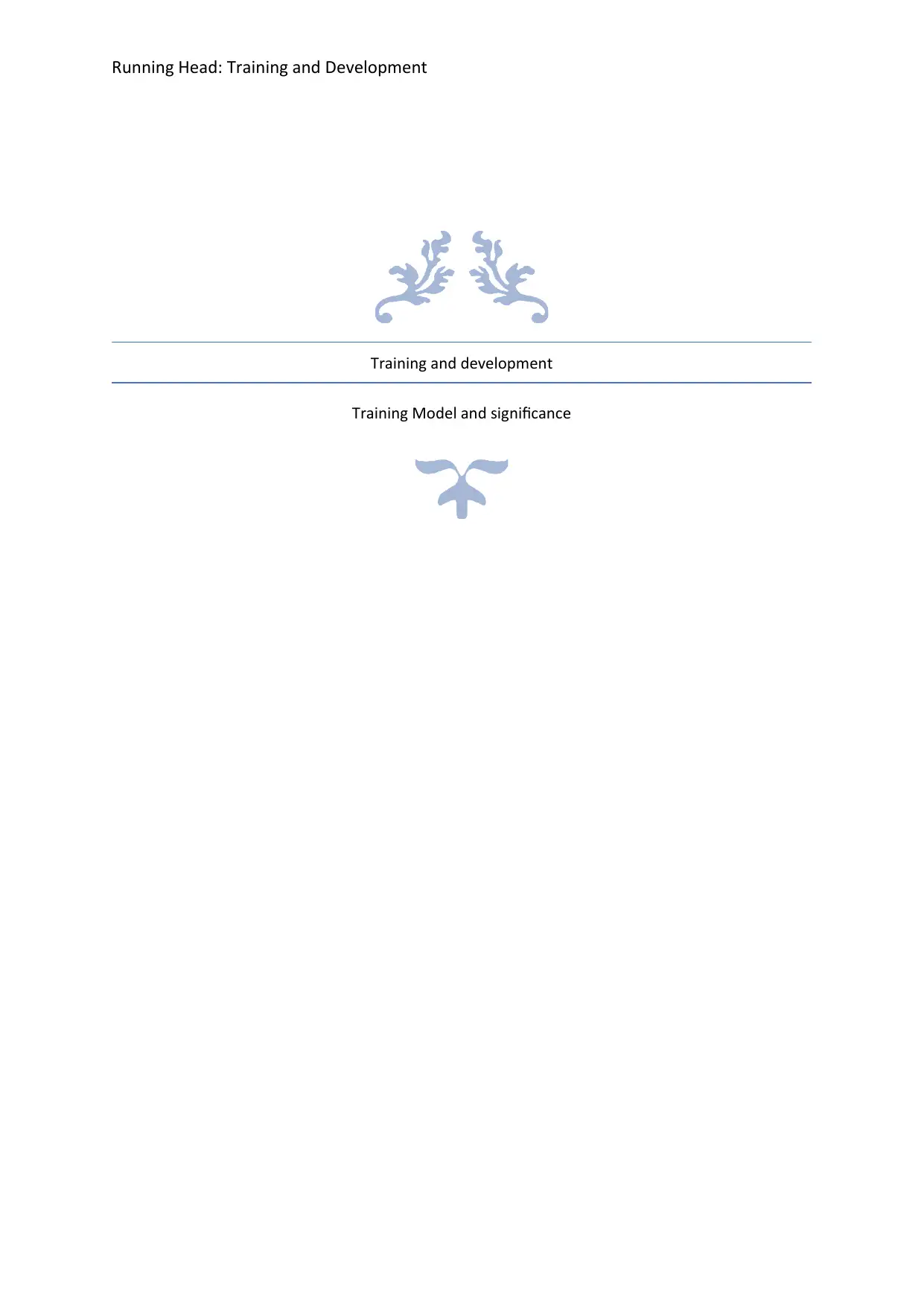
Running Head: Training and Development
Training and development
Training Model and significance
Training and development
Training Model and significance
Paraphrase This Document
Need a fresh take? Get an instant paraphrase of this document with our AI Paraphraser
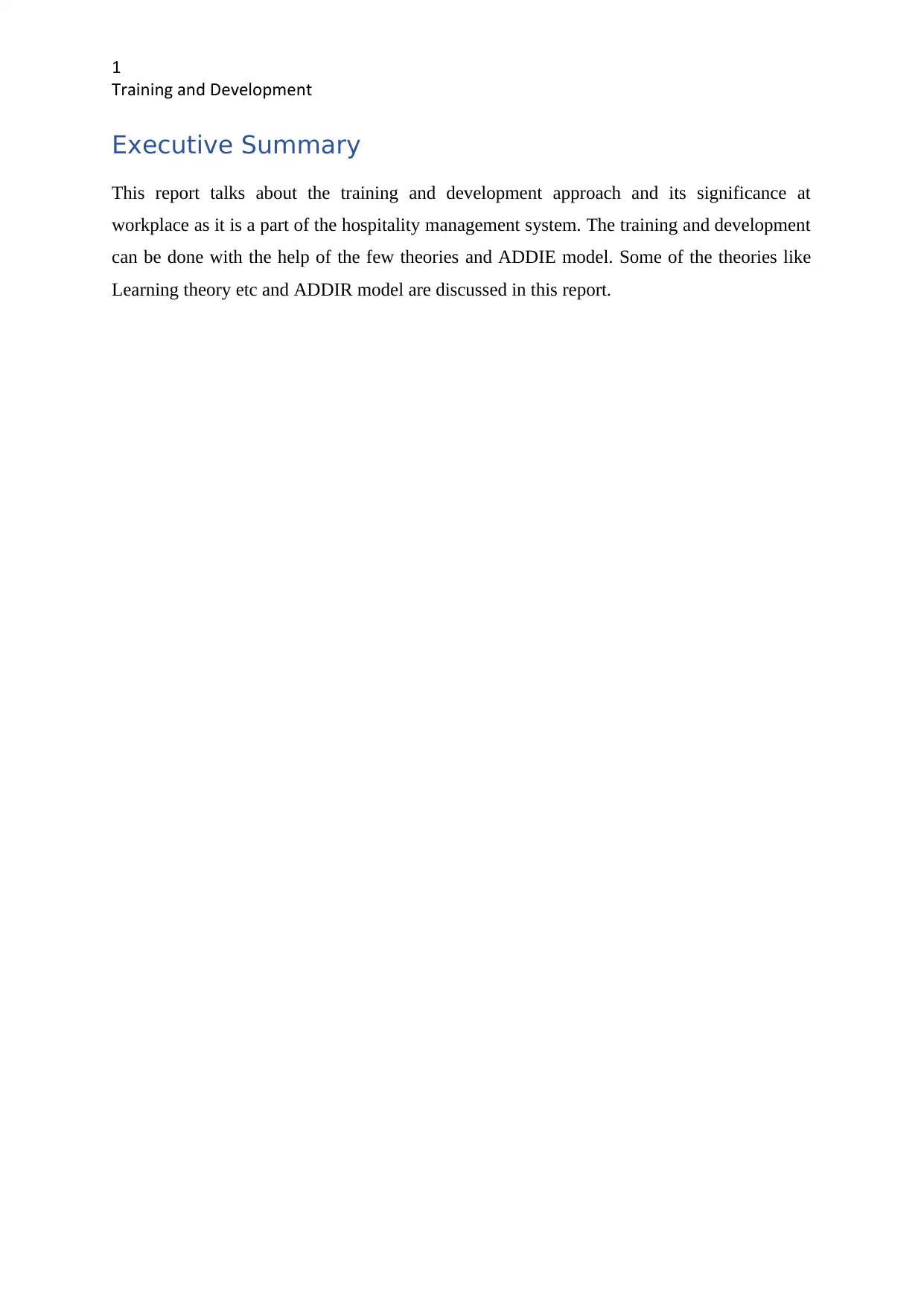
1
Training and Development
Executive Summary
This report talks about the training and development approach and its significance at
workplace as it is a part of the hospitality management system. The training and development
can be done with the help of the few theories and ADDIE model. Some of the theories like
Learning theory etc and ADDIR model are discussed in this report.
Training and Development
Executive Summary
This report talks about the training and development approach and its significance at
workplace as it is a part of the hospitality management system. The training and development
can be done with the help of the few theories and ADDIE model. Some of the theories like
Learning theory etc and ADDIR model are discussed in this report.
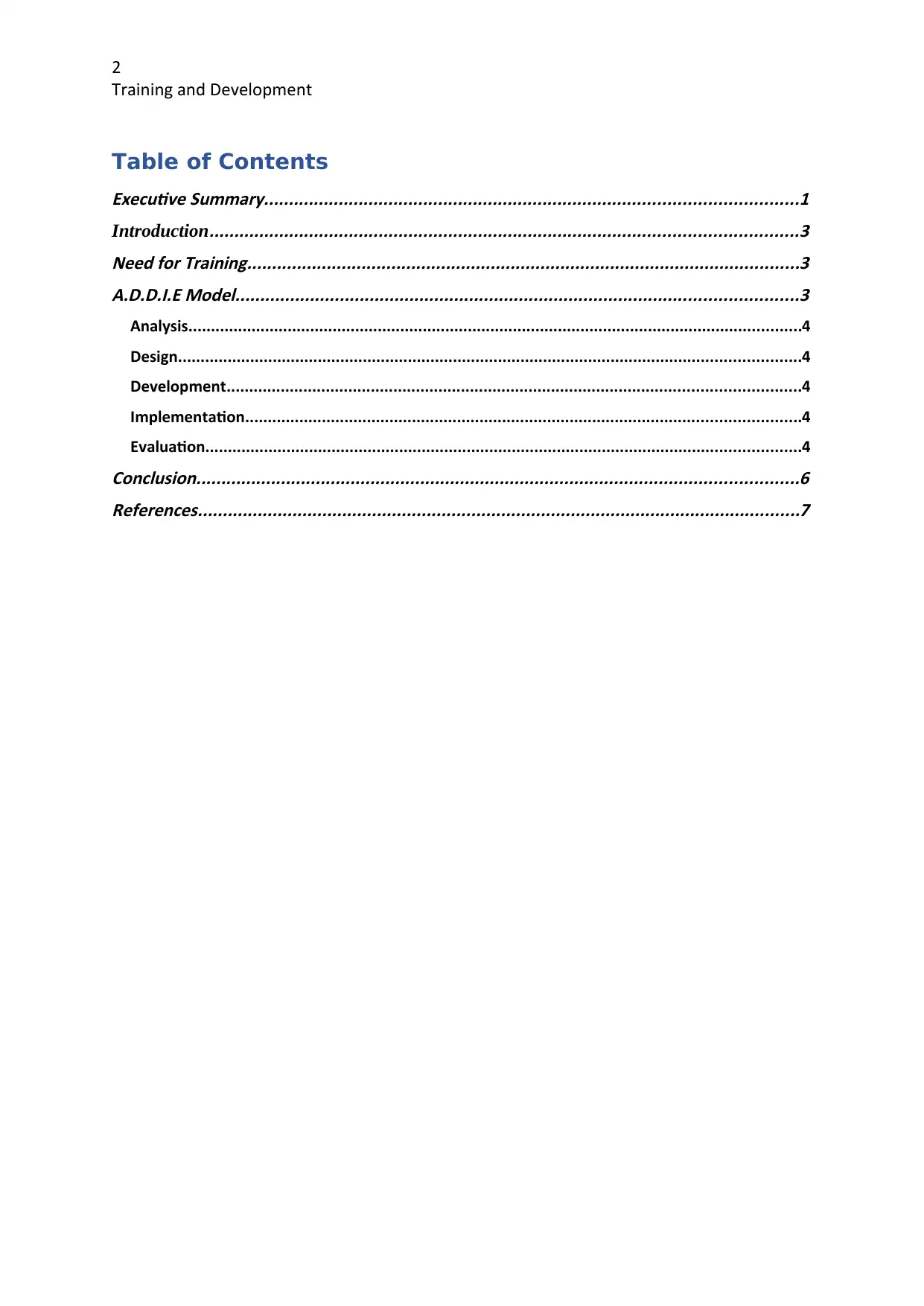
2
Training and Development
Table of ContentsExecutive Summary...........................................................................................................1
Introduction
......................................................................................................................3
Need for Training...............................................................................................................3
A.D.D.I.E Model.................................................................................................................3
Analysis........................................................................................................................................4
Design..........................................................................................................................................4
Development...............................................................................................................................4
Implementation...........................................................................................................................4
Evaluation....................................................................................................................................4Conclusion.........................................................................................................................6
References.........................................................................................................................7
Training and Development
Table of ContentsExecutive Summary...........................................................................................................1
Introduction
......................................................................................................................3
Need for Training...............................................................................................................3
A.D.D.I.E Model.................................................................................................................3
Analysis........................................................................................................................................4
Design..........................................................................................................................................4
Development...............................................................................................................................4
Implementation...........................................................................................................................4
Evaluation....................................................................................................................................4Conclusion.........................................................................................................................6
References.........................................................................................................................7
⊘ This is a preview!⊘
Do you want full access?
Subscribe today to unlock all pages.

Trusted by 1+ million students worldwide
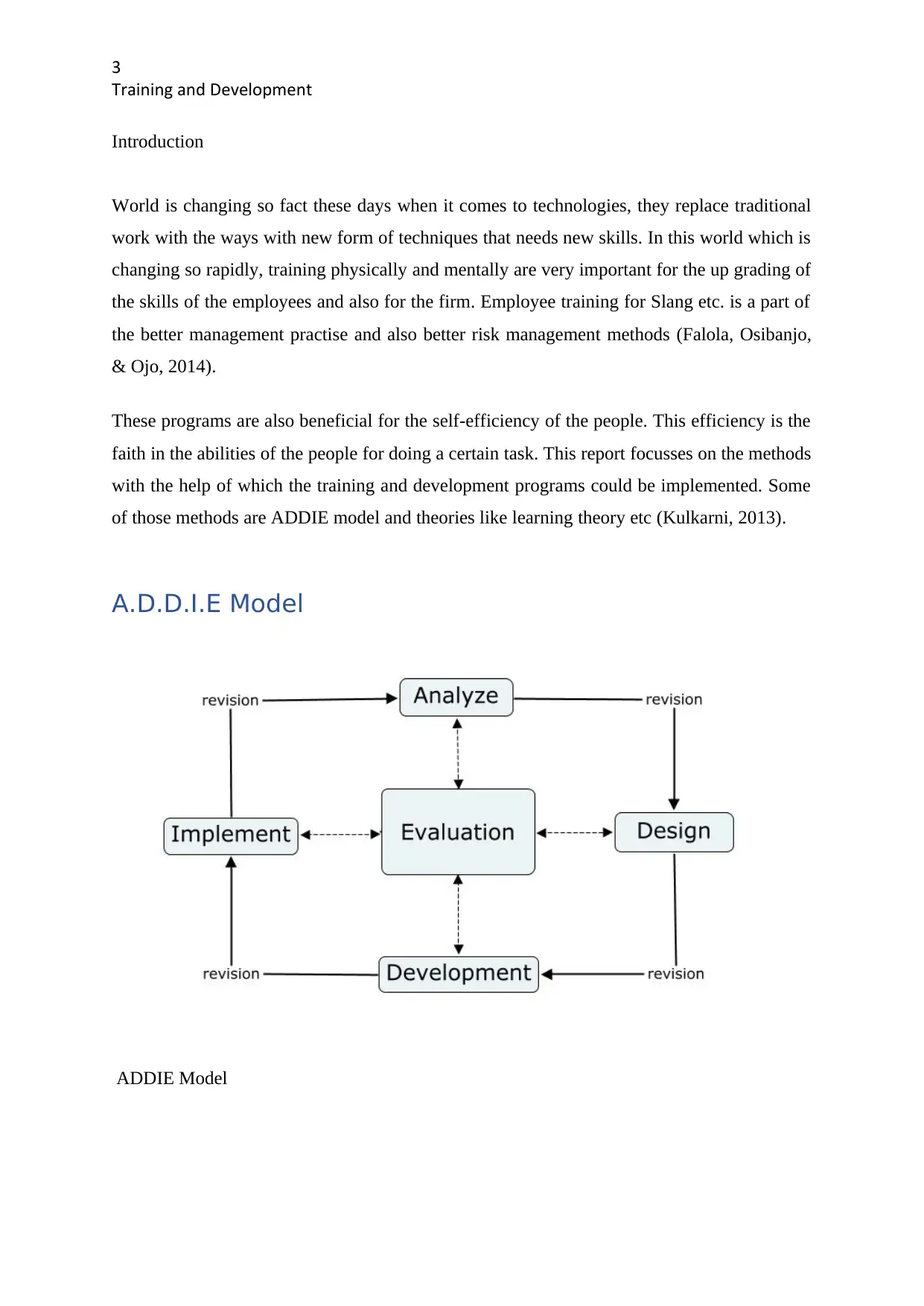
3
Training and Development
Introduction
World is changing so fact these days when it comes to technologies, they replace traditional
work with the ways with new form of techniques that needs new skills. In this world which is
changing so rapidly, training physically and mentally are very important for the up grading of
the skills of the employees and also for the firm. Employee training for Slang etc. is a part of
the better management practise and also better risk management methods (Falola, Osibanjo,
& Ojo, 2014).
These programs are also beneficial for the self-efficiency of the people. This efficiency is the
faith in the abilities of the people for doing a certain task. This report focusses on the methods
with the help of which the training and development programs could be implemented. Some
of those methods are ADDIE model and theories like learning theory etc (Kulkarni, 2013).
A.D.D.I.E Model
ADDIE Model
Training and Development
Introduction
World is changing so fact these days when it comes to technologies, they replace traditional
work with the ways with new form of techniques that needs new skills. In this world which is
changing so rapidly, training physically and mentally are very important for the up grading of
the skills of the employees and also for the firm. Employee training for Slang etc. is a part of
the better management practise and also better risk management methods (Falola, Osibanjo,
& Ojo, 2014).
These programs are also beneficial for the self-efficiency of the people. This efficiency is the
faith in the abilities of the people for doing a certain task. This report focusses on the methods
with the help of which the training and development programs could be implemented. Some
of those methods are ADDIE model and theories like learning theory etc (Kulkarni, 2013).
A.D.D.I.E Model
ADDIE Model
Paraphrase This Document
Need a fresh take? Get an instant paraphrase of this document with our AI Paraphraser
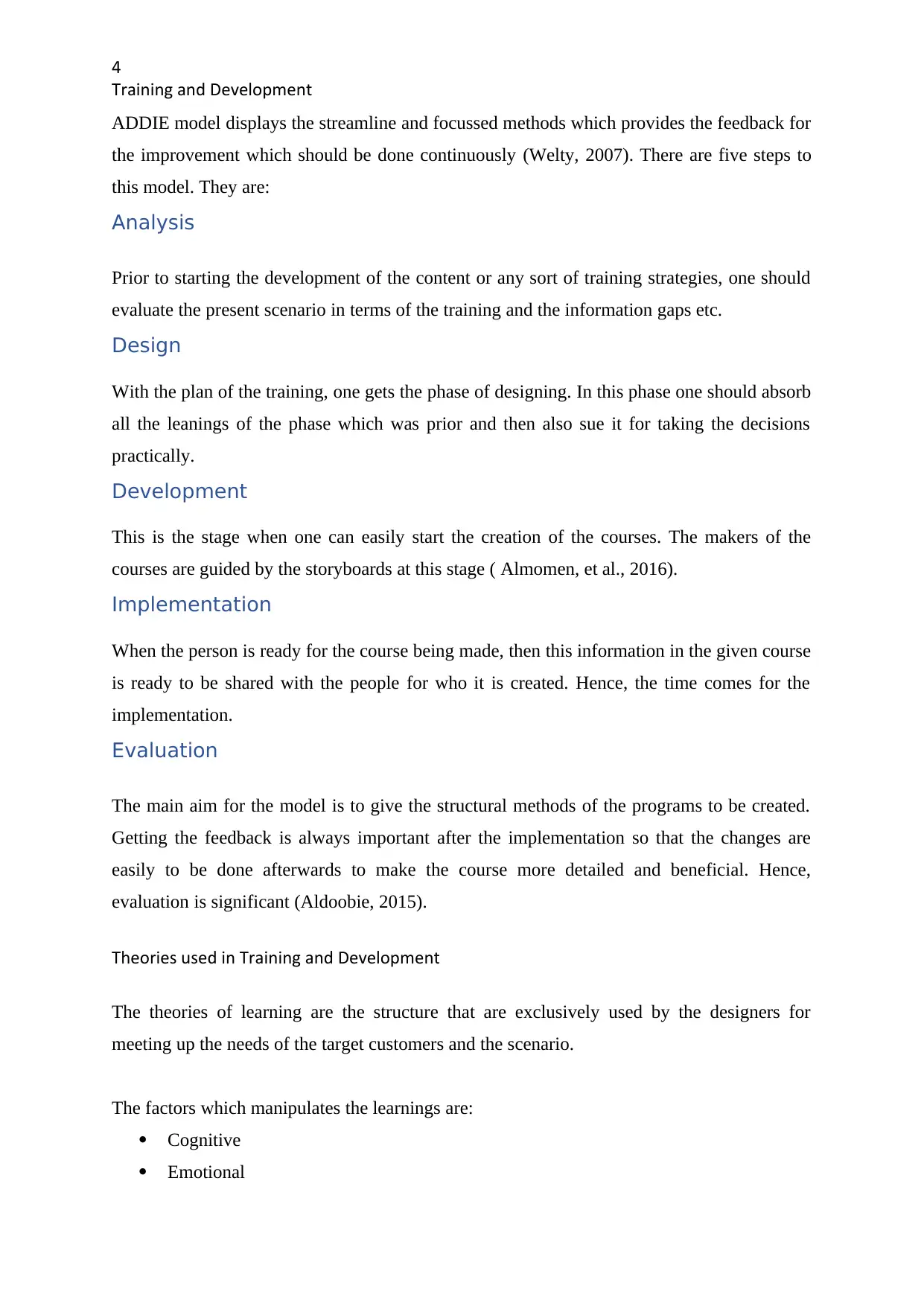
4
Training and Development
ADDIE model displays the streamline and focussed methods which provides the feedback for
the improvement which should be done continuously (Welty, 2007). There are five steps to
this model. They are:
Analysis
Prior to starting the development of the content or any sort of training strategies, one should
evaluate the present scenario in terms of the training and the information gaps etc.
Design
With the plan of the training, one gets the phase of designing. In this phase one should absorb
all the leanings of the phase which was prior and then also sue it for taking the decisions
practically.
Development
This is the stage when one can easily start the creation of the courses. The makers of the
courses are guided by the storyboards at this stage ( Almomen, et al., 2016).
Implementation
When the person is ready for the course being made, then this information in the given course
is ready to be shared with the people for who it is created. Hence, the time comes for the
implementation.
Evaluation
The main aim for the model is to give the structural methods of the programs to be created.
Getting the feedback is always important after the implementation so that the changes are
easily to be done afterwards to make the course more detailed and beneficial. Hence,
evaluation is significant (Aldoobie, 2015).
Theories used in Training and Development
The theories of learning are the structure that are exclusively used by the designers for
meeting up the needs of the target customers and the scenario.
The factors which manipulates the learnings are:
Cognitive
Emotional
Training and Development
ADDIE model displays the streamline and focussed methods which provides the feedback for
the improvement which should be done continuously (Welty, 2007). There are five steps to
this model. They are:
Analysis
Prior to starting the development of the content or any sort of training strategies, one should
evaluate the present scenario in terms of the training and the information gaps etc.
Design
With the plan of the training, one gets the phase of designing. In this phase one should absorb
all the leanings of the phase which was prior and then also sue it for taking the decisions
practically.
Development
This is the stage when one can easily start the creation of the courses. The makers of the
courses are guided by the storyboards at this stage ( Almomen, et al., 2016).
Implementation
When the person is ready for the course being made, then this information in the given course
is ready to be shared with the people for who it is created. Hence, the time comes for the
implementation.
Evaluation
The main aim for the model is to give the structural methods of the programs to be created.
Getting the feedback is always important after the implementation so that the changes are
easily to be done afterwards to make the course more detailed and beneficial. Hence,
evaluation is significant (Aldoobie, 2015).
Theories used in Training and Development
The theories of learning are the structure that are exclusively used by the designers for
meeting up the needs of the target customers and the scenario.
The factors which manipulates the learnings are:
Cognitive
Emotional
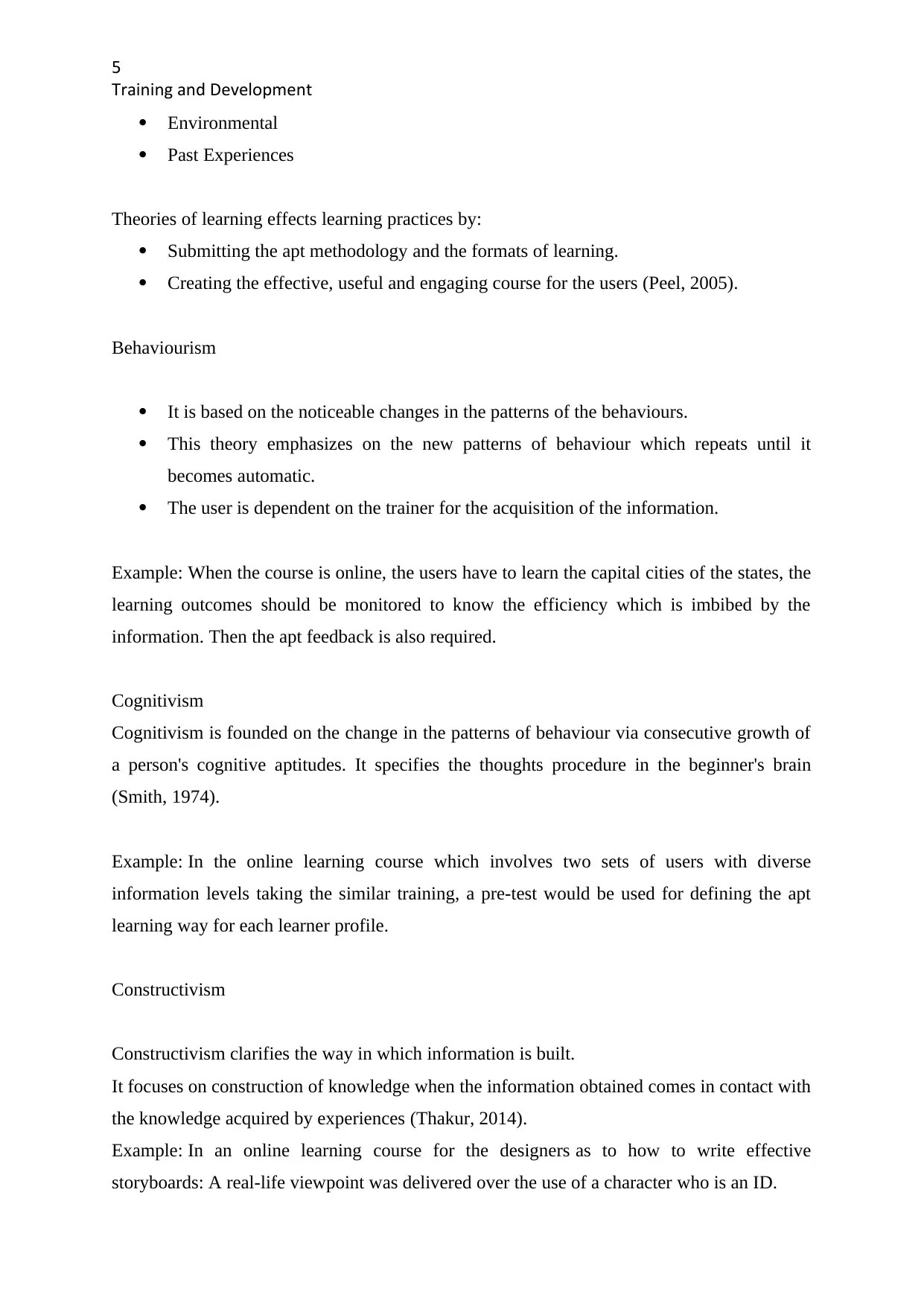
5
Training and Development
Environmental
Past Experiences
Theories of learning effects learning practices by:
Submitting the apt methodology and the formats of learning.
Creating the effective, useful and engaging course for the users (Peel, 2005).
Behaviourism
It is based on the noticeable changes in the patterns of the behaviours.
This theory emphasizes on the new patterns of behaviour which repeats until it
becomes automatic.
The user is dependent on the trainer for the acquisition of the information.
Example: When the course is online, the users have to learn the capital cities of the states, the
learning outcomes should be monitored to know the efficiency which is imbibed by the
information. Then the apt feedback is also required.
Cognitivism
Cognitivism is founded on the change in the patterns of behaviour via consecutive growth of
a person's cognitive aptitudes. It specifies the thoughts procedure in the beginner's brain
(Smith, 1974).
Example: In the online learning course which involves two sets of users with diverse
information levels taking the similar training, a pre-test would be used for defining the apt
learning way for each learner profile.
Constructivism
Constructivism clarifies the way in which information is built.
It focuses on construction of knowledge when the information obtained comes in contact with
the knowledge acquired by experiences (Thakur, 2014).
Example: In an online learning course for the designers as to how to write effective
storyboards: A real-life viewpoint was delivered over the use of a character who is an ID.
Training and Development
Environmental
Past Experiences
Theories of learning effects learning practices by:
Submitting the apt methodology and the formats of learning.
Creating the effective, useful and engaging course for the users (Peel, 2005).
Behaviourism
It is based on the noticeable changes in the patterns of the behaviours.
This theory emphasizes on the new patterns of behaviour which repeats until it
becomes automatic.
The user is dependent on the trainer for the acquisition of the information.
Example: When the course is online, the users have to learn the capital cities of the states, the
learning outcomes should be monitored to know the efficiency which is imbibed by the
information. Then the apt feedback is also required.
Cognitivism
Cognitivism is founded on the change in the patterns of behaviour via consecutive growth of
a person's cognitive aptitudes. It specifies the thoughts procedure in the beginner's brain
(Smith, 1974).
Example: In the online learning course which involves two sets of users with diverse
information levels taking the similar training, a pre-test would be used for defining the apt
learning way for each learner profile.
Constructivism
Constructivism clarifies the way in which information is built.
It focuses on construction of knowledge when the information obtained comes in contact with
the knowledge acquired by experiences (Thakur, 2014).
Example: In an online learning course for the designers as to how to write effective
storyboards: A real-life viewpoint was delivered over the use of a character who is an ID.
⊘ This is a preview!⊘
Do you want full access?
Subscribe today to unlock all pages.

Trusted by 1+ million students worldwide
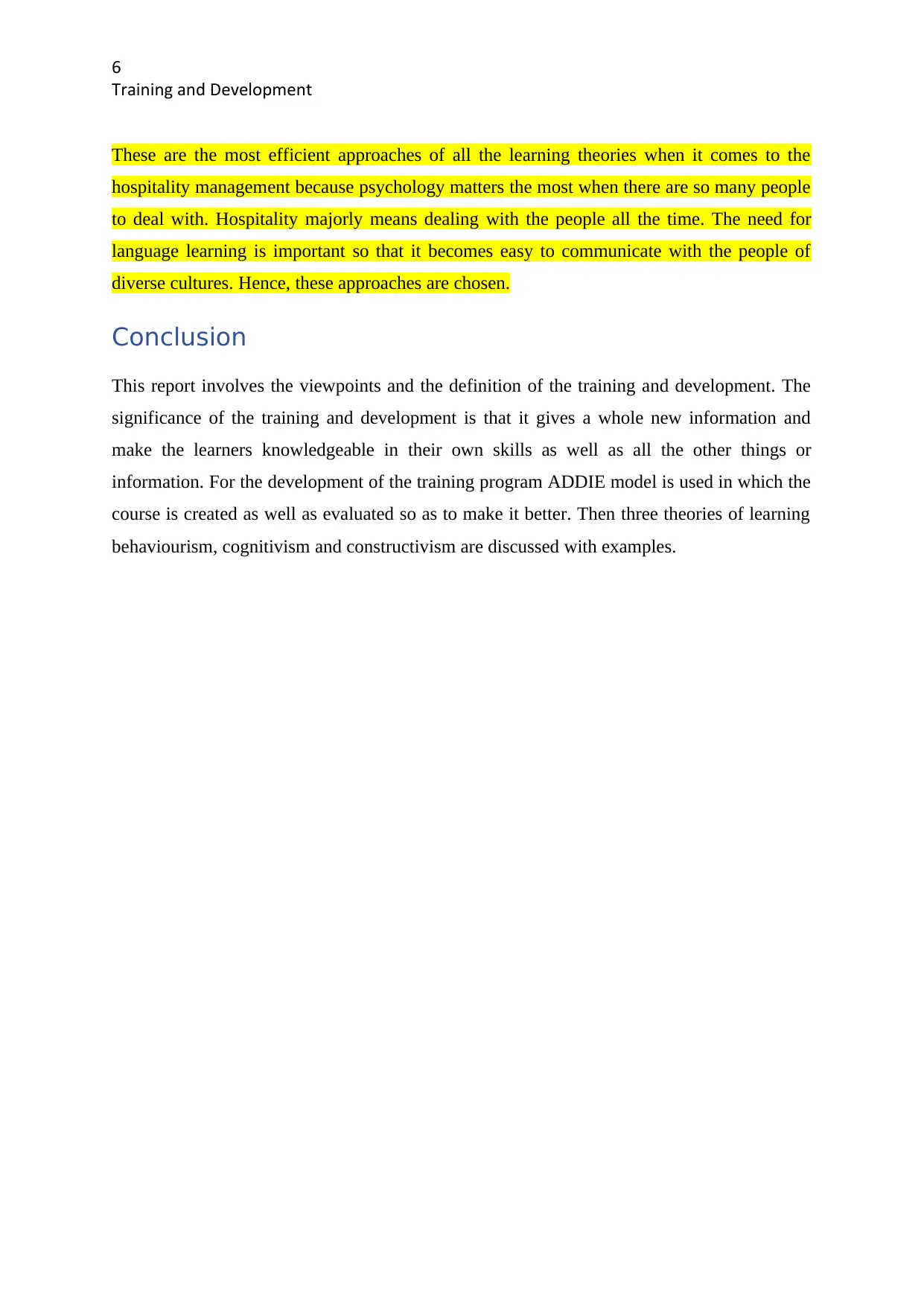
6
Training and Development
These are the most efficient approaches of all the learning theories when it comes to the
hospitality management because psychology matters the most when there are so many people
to deal with. Hospitality majorly means dealing with the people all the time. The need for
language learning is important so that it becomes easy to communicate with the people of
diverse cultures. Hence, these approaches are chosen.
Conclusion
This report involves the viewpoints and the definition of the training and development. The
significance of the training and development is that it gives a whole new information and
make the learners knowledgeable in their own skills as well as all the other things or
information. For the development of the training program ADDIE model is used in which the
course is created as well as evaluated so as to make it better. Then three theories of learning
behaviourism, cognitivism and constructivism are discussed with examples.
Training and Development
These are the most efficient approaches of all the learning theories when it comes to the
hospitality management because psychology matters the most when there are so many people
to deal with. Hospitality majorly means dealing with the people all the time. The need for
language learning is important so that it becomes easy to communicate with the people of
diverse cultures. Hence, these approaches are chosen.
Conclusion
This report involves the viewpoints and the definition of the training and development. The
significance of the training and development is that it gives a whole new information and
make the learners knowledgeable in their own skills as well as all the other things or
information. For the development of the training program ADDIE model is used in which the
course is created as well as evaluated so as to make it better. Then three theories of learning
behaviourism, cognitivism and constructivism are discussed with examples.
Paraphrase This Document
Need a fresh take? Get an instant paraphrase of this document with our AI Paraphraser
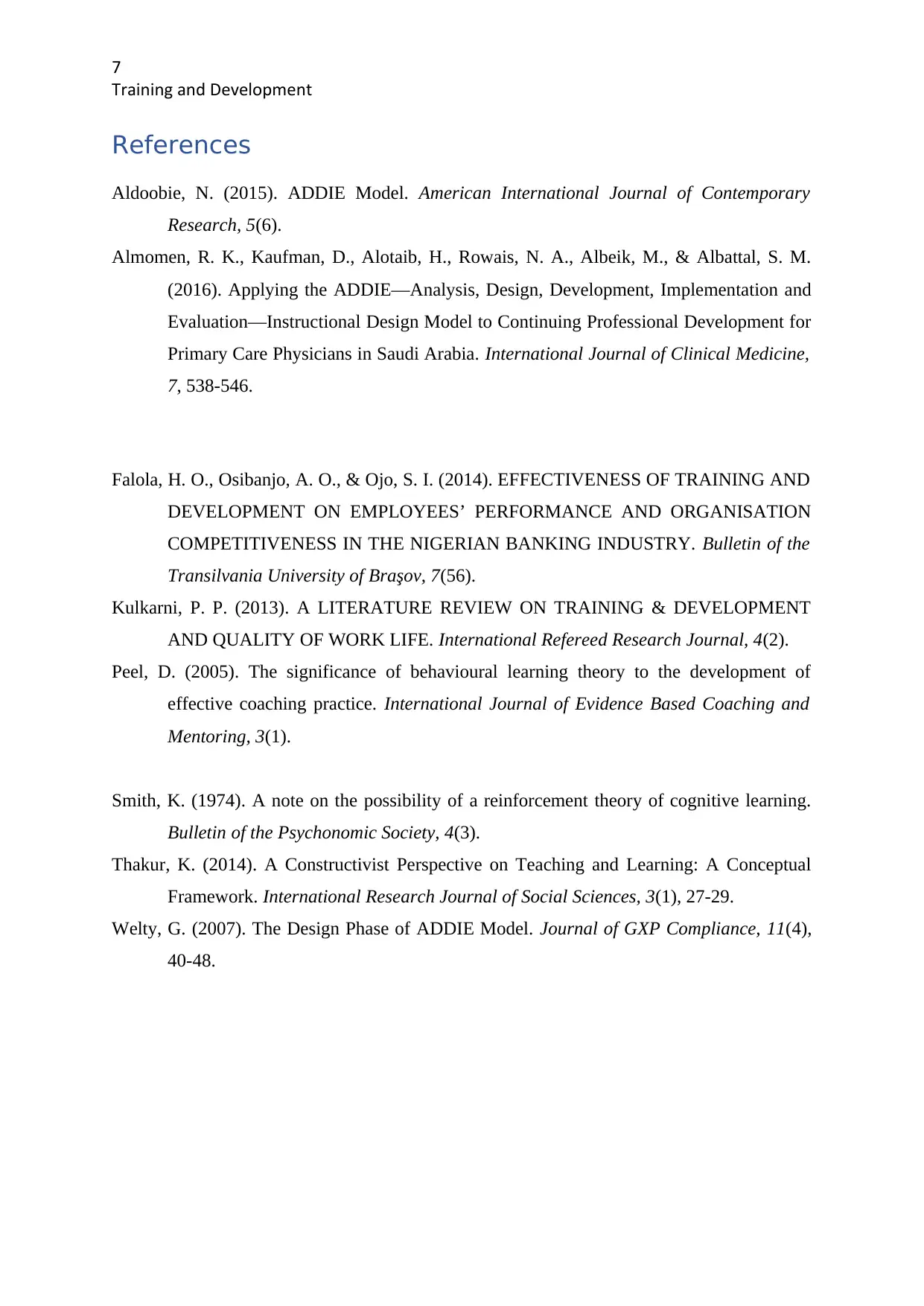
7
Training and Development
References
Aldoobie, N. (2015). ADDIE Model. American International Journal of Contemporary
Research, 5(6).
Almomen, R. K., Kaufman, D., Alotaib, H., Rowais, N. A., Albeik, M., & Albattal, S. M.
(2016). Applying the ADDIE—Analysis, Design, Development, Implementation and
Evaluation—Instructional Design Model to Continuing Professional Development for
Primary Care Physicians in Saudi Arabia. International Journal of Clinical Medicine,
7, 538-546.
Falola, H. O., Osibanjo, A. O., & Ojo, S. I. (2014). EFFECTIVENESS OF TRAINING AND
DEVELOPMENT ON EMPLOYEES’ PERFORMANCE AND ORGANISATION
COMPETITIVENESS IN THE NIGERIAN BANKING INDUSTRY. Bulletin of the
Transilvania University of Braşov, 7(56).
Kulkarni, P. P. (2013). A LITERATURE REVIEW ON TRAINING & DEVELOPMENT
AND QUALITY OF WORK LIFE. International Refereed Research Journal, 4(2).
Peel, D. (2005). The significance of behavioural learning theory to the development of
effective coaching practice. International Journal of Evidence Based Coaching and
Mentoring, 3(1).
Smith, K. (1974). A note on the possibility of a reinforcement theory of cognitive learning.
Bulletin of the Psychonomic Society, 4(3).
Thakur, K. (2014). A Constructivist Perspective on Teaching and Learning: A Conceptual
Framework. International Research Journal of Social Sciences, 3(1), 27-29.
Welty, G. (2007). The Design Phase of ADDIE Model. Journal of GXP Compliance, 11(4),
40-48.
Training and Development
References
Aldoobie, N. (2015). ADDIE Model. American International Journal of Contemporary
Research, 5(6).
Almomen, R. K., Kaufman, D., Alotaib, H., Rowais, N. A., Albeik, M., & Albattal, S. M.
(2016). Applying the ADDIE—Analysis, Design, Development, Implementation and
Evaluation—Instructional Design Model to Continuing Professional Development for
Primary Care Physicians in Saudi Arabia. International Journal of Clinical Medicine,
7, 538-546.
Falola, H. O., Osibanjo, A. O., & Ojo, S. I. (2014). EFFECTIVENESS OF TRAINING AND
DEVELOPMENT ON EMPLOYEES’ PERFORMANCE AND ORGANISATION
COMPETITIVENESS IN THE NIGERIAN BANKING INDUSTRY. Bulletin of the
Transilvania University of Braşov, 7(56).
Kulkarni, P. P. (2013). A LITERATURE REVIEW ON TRAINING & DEVELOPMENT
AND QUALITY OF WORK LIFE. International Refereed Research Journal, 4(2).
Peel, D. (2005). The significance of behavioural learning theory to the development of
effective coaching practice. International Journal of Evidence Based Coaching and
Mentoring, 3(1).
Smith, K. (1974). A note on the possibility of a reinforcement theory of cognitive learning.
Bulletin of the Psychonomic Society, 4(3).
Thakur, K. (2014). A Constructivist Perspective on Teaching and Learning: A Conceptual
Framework. International Research Journal of Social Sciences, 3(1), 27-29.
Welty, G. (2007). The Design Phase of ADDIE Model. Journal of GXP Compliance, 11(4),
40-48.

8
Training and Development
Training and Development
⊘ This is a preview!⊘
Do you want full access?
Subscribe today to unlock all pages.

Trusted by 1+ million students worldwide
1 out of 9
Related Documents
Your All-in-One AI-Powered Toolkit for Academic Success.
+13062052269
info@desklib.com
Available 24*7 on WhatsApp / Email
![[object Object]](/_next/static/media/star-bottom.7253800d.svg)
Unlock your academic potential
Copyright © 2020–2025 A2Z Services. All Rights Reserved. Developed and managed by ZUCOL.





